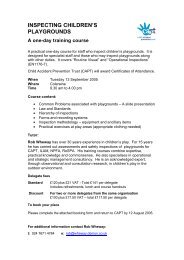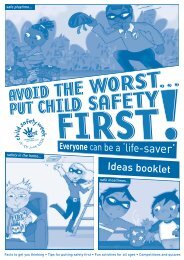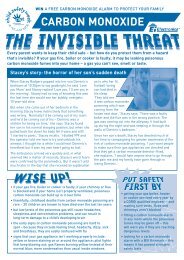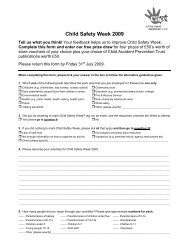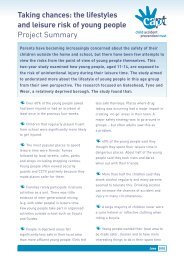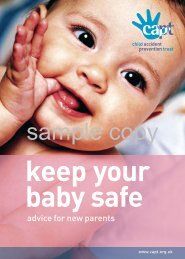You also want an ePaper? Increase the reach of your titles
YUMPU automatically turns print PDFs into web optimized ePapers that Google loves.
<strong>Kitchen</strong><strong>safety</strong><br />
Quiz for parents and carers<br />
<strong>Kitchen</strong>s are at the heart of most family homes.<br />
But they can be dangerous places for young<br />
children – who may be burnt, poisoned or<br />
suffer nasty falls.<br />
Make your kitchen a family-friendly place by<br />
taking time to spot the dangers. If you can, get<br />
down on your hands and knees to look at the<br />
world through a young child’s eyes – and see<br />
what might harm crawling babies, curious<br />
toddlers or growing bundles of energy.<br />
Take a look at our <strong>safety</strong> tips. Then test your<br />
knowledge in our quiz.<br />
www.istockphoto.com/Petro Feketa<br />
credit
<strong>Kitchen</strong> <strong>safety</strong><br />
Quiz for parents and carers<br />
Safety tips<br />
Young children are hugely curious – and<br />
one of the ways they learn is by putting<br />
things in their mouths. While childresistant<br />
caps are helpful as they slow<br />
young children down, they are not<br />
completely child-proof. Some three and<br />
four-year-olds can open them in<br />
seconds. So keep all cleaning products<br />
on a high shelf or in a cupboard with<br />
child-resistant locks.<br />
Young children can mistake tablets for<br />
sweets, so take care not to leave them<br />
out on work surfaces or in unlocked<br />
kitchen drawers. And try to avoid taking<br />
them when young children are watching<br />
– as they may want to copy you.<br />
Most medicines that need to be stored in<br />
a cool place don’t need to be kept in the<br />
fridge. Check the label. If it does need to<br />
be stored in the fridge, keep it as high up<br />
and hidden as possible.<br />
A young child’s skin is much thinner<br />
than an adult’s, so they burn much<br />
more easily. Little hands can grab at<br />
hanging leads, so use a kettle with a<br />
short or curly flex. And keep it pushed<br />
to the back of your work surface.<br />
A mug of tea or coffee can still scald a<br />
young child 15 minutes after it’s been<br />
made. So keep hot drinks well out of<br />
young children’s reach. And don’t hold a<br />
baby on your lap when you’ve a hot<br />
drink in your hand – in case they grab at<br />
the mug, and end up badly scalded.<br />
Pan handles can look intriguing from a<br />
toddler’s point of view. So use the rings<br />
at the back of the cooker, with the<br />
handles turned towards the back, so<br />
little fingers can’t grab them. And keep<br />
children away from the oven door to<br />
prevent nasty burns.<br />
If chip pans catch fire, they can cause<br />
horrific injuries and even start house<br />
fires. It’s safer to replace your chip pan<br />
with an electric deep-fat fryer. Oven<br />
chips are also a safer alternative. If you<br />
can’t do this, don’t fill your chip pan<br />
more than one-third full with oil.<br />
If you have young children around, it<br />
may be safer to keep them out of the<br />
kitchen until you have finished<br />
preparing the meal. You can use a<br />
<strong>safety</strong> gate across the kitchen door to<br />
keep small children out of harm’s way.<br />
If you have room, a playpen in the<br />
corner of the kitchen can also provide a<br />
safe haven.<br />
Small children's throats are much<br />
narrower than adults, so they choke<br />
much more easily. Cut food into small<br />
pieces and teach children to sit down<br />
when they are eating. Remember that<br />
even soft things like grapes may be too<br />
big for a small child’s throat – so put<br />
<strong>safety</strong> first by cutting them up.<br />
www.istockphoto.com/Feng Yu<br />
see next page for quiz
<strong>Kitchen</strong> <strong>safety</strong><br />
Quiz for parents and carers<br />
Test your <strong>safety</strong> knowledge by walking around our imaginary<br />
kitchen and deciding how to keep your family safe. Choose from<br />
A, B or C below. Then check how well you did against the<br />
answers at the next page.<br />
1<br />
2<br />
3<br />
4<br />
The door to the cupboard under the sink is open. You can see a bottle of bleach,<br />
with its child-resistant top fastened. Is this:<br />
(a) dangerous, because small children can open and drink cleaning products<br />
(b) OK because young children can’t open child-resistant tops<br />
(c) fine because you’ll remember to move the bottle later<br />
You decide to make a meal for your family. While you are cooking, the most<br />
important thing is to:<br />
(a) use every pan in the house<br />
(b) cook as quickly as possible<br />
(c) use the back rings on the cooker and keep pan handles turned towards the back<br />
You want to cook some chips for the family. What’s the safest way of doing this?<br />
(a) in a chip pan filled with hot oil<br />
(b) in an electric deep-fat fryer or using oven chips<br />
(c) under the grill<br />
You go over to the fruit bowl and see a bunch of grapes.<br />
You know that fruit is good for children so you:<br />
(a) hand the bunch of grapes to your toddler<br />
(b) eat the grapes yourself<br />
(c) cut the grapes into pieces so your toddler won’t choke<br />
5<br />
You decide to take a break and make a mug of coffee. You put your baby in the<br />
playpen while you drink this because:<br />
(a) babies don’t like the smell of coffee<br />
(b) a baby’s skin is 15 times thinner than an adult’s. They might reach for<br />
the mug and get badly scalded<br />
(c) you don’t want your baby to spill coffee on your crossword puzzle<br />
So how safe would your family be in our imaginary kitchen?<br />
See the next page for the answers.<br />
www.istockphoto.com/Huchen Lu
<strong>Kitchen</strong> <strong>safety</strong><br />
Quiz for parents and carers<br />
Answers<br />
1: a.<br />
Child-resistant tops aren’t completely childproof.<br />
Some young children can open them in seconds – just<br />
at the moment your back is turned! So move cleaning<br />
products onto a high shelf out of reach. Or put them in<br />
a cupboard with child-resistant locks.<br />
2: c.<br />
It’s important to use the back rings on the cooker and<br />
to keep pan handles turned away, so that small hands<br />
can’t grab them.<br />
3: b.<br />
If you have to use a chip pan, then make sure it is only<br />
a third full with oil. And never leave chip pans<br />
unsupervised because they can catch fire very quickly.<br />
4: c.<br />
Small children choke much more easily than adults,<br />
as their throats are much narrower. They can even<br />
choke on soft things like grapes. So cut food up into<br />
small pieces.<br />
5: b.<br />
Make sure you only relax with a hot drink when there<br />
is no chance you might scald your baby. It’s a<br />
surprising fact that a mug of tea or coffee can still<br />
scald a baby 15 minutes after it’s been made because<br />
their skin is so much thinner than an adult’s.<br />
www.istockphoto.com/Silvia Jansen<br />
The Scottish Government is a proud sponsor of Child Safety Week 2008.<br />
To find out more visit www.scotland.gov.uk<br />
For more information about keeping children safe, visit the Child Accident<br />
Prevention Trust’s website www.capt.org.uk<br />
Photocopying is permitted for non-commercial use provided that each sheet is reproduced precisely and retains all logos



